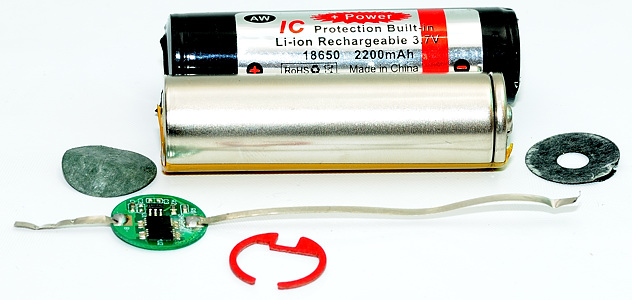fedcas
New Member
I’ve been googling for this for a while. I have a - poorly designed - circuit (it's a step-up regulator for a usb powerbank, this one actually **broken link removed** ) which has no low voltage cut-off so I want to add one. Actually i'm running it with a protected 18650, but i still want an external cutoff because:
1) 18650 protection board cutoff kicks in at 2.5-2.4V which i think is definitely too low for daily use
2) a protection circuit should be the last resort in case something goes wrong, i don’t think it should be used on a regular basis (and i don’t know how reliable they are)
3) battery integrated overdischarge protection must not prevent the battery from operating correctly in any operating scenario, either under low or high loads... that means the cutoff is set to a very low value to avoid that with high discharge currents (high voltage sag) it kicks in before the battery has discharged completely
It looks like a simple and common problem, but apparently the solution is not as simple. I've found many threads on forums and many pages... a lot of talks, hints and good ideas, very few tested circuits though... but here's a couple of interesting links:
http://hackaday.com/2011/12/01/from-the-readers-low-battery-cutoff-solutions/ (read the comments as well)
**broken link removed**
many of those circuits require microcontrollers, which i don't want to use, and the simple ones have all have some drawbacks that made me discard them. So what is left are dedicated protection boards.
But again, a couple suggested in the blog post linked above http://www.all-battery.com/1S_Li-Ion.aspx looks great having the 2.9-3.0v cutoff, but that shop is only a solution for people living in the us. As i live in europe i’ve had a look to protection pcbs on ebay and aliexpress, cheap and easy, but i can only find circuits with cutoff at 2.5v or 2.4v while something around 3.0v is needed… if anyone finds something it would be much appreciated
SO:
here’s my idea, i'd like to have some opinions as i have just a very basic electronic knowledge:
Since finding a board programmed for 3.0v cutoff seems too complicated, i thought to tweak the common 2.5 cutoff board that i can easily steal from a any 18650 i have laying around or just buy a bunch of them on aliexpress for as low as 1$ shipped or less:
**broken link removed**
Then I can use a voltage divider with just 2 resistors to set the kick in voltage wherever i want, instead of connecting the board reference directly to the positive electrode… of course resistors in the Kohm-Mohm range would be needed to avoid battery drain, and it’s probably a good idea to add a capacitor when using so high resistor values for the reason explained here http://jeelabs.org/2013/05/16/measuring-the-battery-without-draining-it/ (i don’t know much about microcontrollers, but i guess this high impedance thing might be a common issue).
Any suggestion/better idea?
1) 18650 protection board cutoff kicks in at 2.5-2.4V which i think is definitely too low for daily use
2) a protection circuit should be the last resort in case something goes wrong, i don’t think it should be used on a regular basis (and i don’t know how reliable they are)
3) battery integrated overdischarge protection must not prevent the battery from operating correctly in any operating scenario, either under low or high loads... that means the cutoff is set to a very low value to avoid that with high discharge currents (high voltage sag) it kicks in before the battery has discharged completely
It looks like a simple and common problem, but apparently the solution is not as simple. I've found many threads on forums and many pages... a lot of talks, hints and good ideas, very few tested circuits though... but here's a couple of interesting links:
http://hackaday.com/2011/12/01/from-the-readers-low-battery-cutoff-solutions/ (read the comments as well)
**broken link removed**
many of those circuits require microcontrollers, which i don't want to use, and the simple ones have all have some drawbacks that made me discard them. So what is left are dedicated protection boards.
But again, a couple suggested in the blog post linked above http://www.all-battery.com/1S_Li-Ion.aspx looks great having the 2.9-3.0v cutoff, but that shop is only a solution for people living in the us. As i live in europe i’ve had a look to protection pcbs on ebay and aliexpress, cheap and easy, but i can only find circuits with cutoff at 2.5v or 2.4v while something around 3.0v is needed… if anyone finds something it would be much appreciated
SO:
here’s my idea, i'd like to have some opinions as i have just a very basic electronic knowledge:
Since finding a board programmed for 3.0v cutoff seems too complicated, i thought to tweak the common 2.5 cutoff board that i can easily steal from a any 18650 i have laying around or just buy a bunch of them on aliexpress for as low as 1$ shipped or less:
**broken link removed**
Then I can use a voltage divider with just 2 resistors to set the kick in voltage wherever i want, instead of connecting the board reference directly to the positive electrode… of course resistors in the Kohm-Mohm range would be needed to avoid battery drain, and it’s probably a good idea to add a capacitor when using so high resistor values for the reason explained here http://jeelabs.org/2013/05/16/measuring-the-battery-without-draining-it/ (i don’t know much about microcontrollers, but i guess this high impedance thing might be a common issue).
Any suggestion/better idea?
Last edited:



